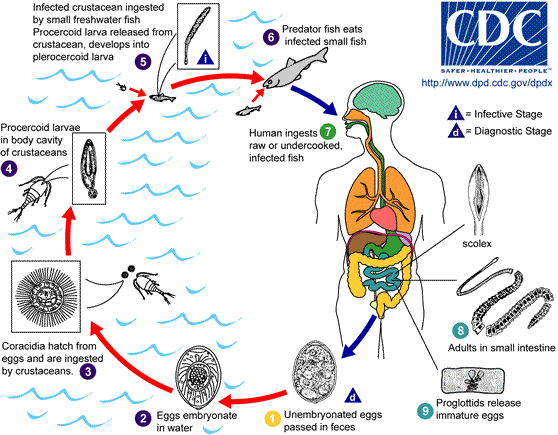|
|
[Last Modified: ] |
|
|
|
| [Diphyllobothrium latum] [Diphyllobothrium spp.] |
Causal Agents:
The cestode Diphyllobothrium
latum (the fish or broad tapeworm), the largest human tapeworm.
Several other Diphyllobothrium
species have been reported to infect humans, but less frequently; they include D.
pacificum, D. cordatum, D. ursi, D. dendriticum, D. lanceolatum, D. dalliae, and D. yonagoensis.

Immature eggs are passed in feces
![]() .
Under appropriate conditions, the eggs mature (approximately 18 to 20 days)
.
Under appropriate conditions, the eggs mature (approximately 18 to 20 days)
![]() and yield oncospheres which develop into a coracidia
and yield oncospheres which develop into a coracidia
![]() .
After ingestion by a suitable freshwater crustacean (the copepod first intermediate host) the coracidia develop
into procercoid larvae
.
After ingestion by a suitable freshwater crustacean (the copepod first intermediate host) the coracidia develop
into procercoid larvae
![]() .
Following ingestion of the copepod by a suitable second intermediate host,
typically minnows and other small freshwater fish, the procercoid larvae
are released from the crustacean and migrate into the fish flesh where
they develop into a plerocercoid larvae
(sparganum)
.
Following ingestion of the copepod by a suitable second intermediate host,
typically minnows and other small freshwater fish, the procercoid larvae
are released from the crustacean and migrate into the fish flesh where
they develop into a plerocercoid larvae
(sparganum)
![]() .
The plerocercoid larvae are the infective stage for humans. Because
humans do not generally eat undercooked minnows and similar small
freshwater fish, these do not represent an important source of infection.
Nevertheless, these small second intermediate hosts can be eaten by larger
predator species, e.g., trout, perch, walleyed pike
.
The plerocercoid larvae are the infective stage for humans. Because
humans do not generally eat undercooked minnows and similar small
freshwater fish, these do not represent an important source of infection.
Nevertheless, these small second intermediate hosts can be eaten by larger
predator species, e.g., trout, perch, walleyed pike
![]() .
In this case, the sparganum can migrate to the musculature of the larger
predator fish and humans can acquire the disease by eating these later
intermediate infected host fish raw or undercooked
.
In this case, the sparganum can migrate to the musculature of the larger
predator fish and humans can acquire the disease by eating these later
intermediate infected host fish raw or undercooked
![]() .
After ingestion of the infected fish, the plerocercoid develop into
immature adults and then into mature adult tapeworms which will reside in
the small intestine. The adults of D. latum attach to the
intestinal mucosa by means of the two bilateral groves (bothria) of their
scolex
.
After ingestion of the infected fish, the plerocercoid develop into
immature adults and then into mature adult tapeworms which will reside in
the small intestine. The adults of D. latum attach to the
intestinal mucosa by means of the two bilateral groves (bothria) of their
scolex
![]() .
The adults can reach more than 10 m in length, with more than 3,000 proglottids.
Immature eggs are discharged from the proglottids (up to 1,000,000 eggs per day per worm)
.
The adults can reach more than 10 m in length, with more than 3,000 proglottids.
Immature eggs are discharged from the proglottids (up to 1,000,000 eggs per day per worm)
![]() and are passed in the feces
and are passed in the feces
![]() .
Eggs appear in the feces 5 to 6 weeks after infection. In addition to humans, many other mammals can also
serve as definitive hosts for D. latum.
.
Eggs appear in the feces 5 to 6 weeks after infection. In addition to humans, many other mammals can also
serve as definitive hosts for D. latum.
Geographic
Distribution:
Diphyllobothriasis
occurs in the Northern
Hemisphere (Europe, newly independent states of the former Soviet Union [NIS], North America, Asia) and in Uganda and Chile.
Freshwater fish infected with Diphyllobothrium sp. larva may be
transported to and consumed in geographic areas where active transmission
does not occur, resulting in human diphyllobothriasis. For example,
cases of D. latum infection associated with consumption of imported
fish have been reported in Brazil.
Reference:
Sampaio JLM, Andrade VP, Lucas MC, et al. Diphyllobothriasis, Brazil. Emerg Infect Dis 2005;11:1598-1600.
|
||||||||